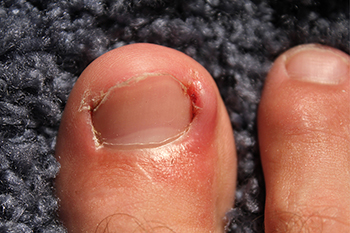
Having an ingrown toenail is a common cause of toe pain. Most ingrown toenails are located on the big toe, resulting in the nail growing into the flesh surrounding it. This results in redness, swelling, and pain. In some cases, the area can become infected, which causes a discharge and pus to form. Experts recommend a few at-home methods to ease the pain and reduce the chances of infection. First soak the foot in warm, salty water to loosen the surrounding skin. Then thoroughly dry the foot and wear wide or open-toed shoes that do not press on the big toe. To prevent getting an ingrown toenail, it is recommended that your toenail be cut straight across and not too short. If the ingrown toenail has become infected or severely painful, it is a good idea to visit a podiatrist. This foot specialist can take measures to alleviate the pain, with the last resort of removing part or all of the toenail. Pain medication and antibiotics, in cases of infection. can also be prescribed by a podiatrist.
Ingrown toenails may initially present themselves as a minor discomfort, but they may progress into an infection in the skin without proper treatment. For more information about ingrown toenails, contact Elliot T. Udell, DPM of New York. Our doctor can provide the care you need to keep you pain-free and on your feet.
Ingrown Toenails
Ingrown toenails are caused when the corner or side of a toenail grows into the soft flesh surrounding it. They often result in redness, swelling, pain, and in some cases, infection. This condition typically affects the big toe and may recur if it is not treated properly.
Causes
- Improper toenail trimming
- Genetics
- Improper shoe fitting
- Injury from pedicures or nail picking
- Abnormal gait
- Poor hygiene
You are more likely to develop an ingrown toenail if you are obese, have diabetes, arthritis, or have any fungal infection in your nails. Additionally, people who have foot or toe deformities are at a higher risk of developing an ingrown toenail.
Symptoms
Some symptoms of ingrown toenails are redness, swelling, and pain. In rare cases, there may be a yellowish drainage coming from the nail.
Treatment
Ignoring an ingrown toenail can have serious complications. Infections of the nail border can progress to a deeper soft-tissue infection, which can then turn into a bone infection. You should always speak with your podiatrist if you suspect you have an ingrown toenail, especially if you have diabetes or poor circulation.
If you have any questions, please feel free to contact our office located in Hicksville, NY . We offer the newest diagnostic and treatment technologies for all your foot care needs.
